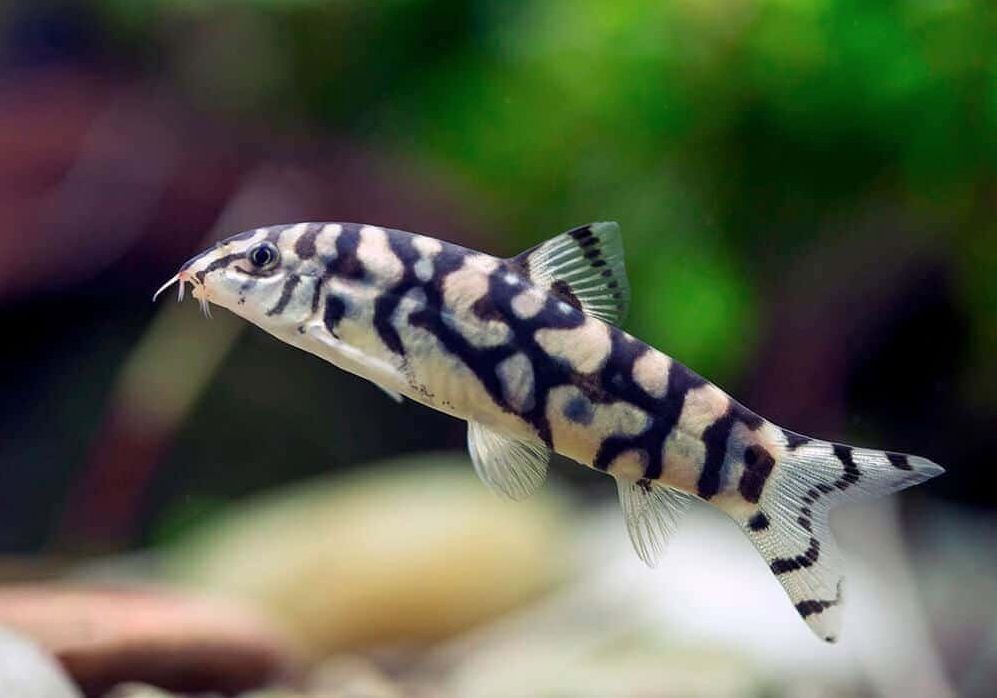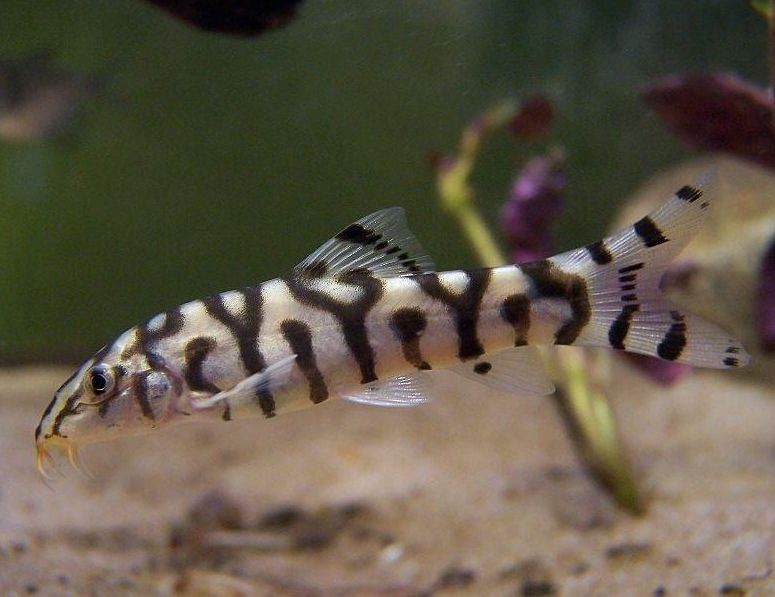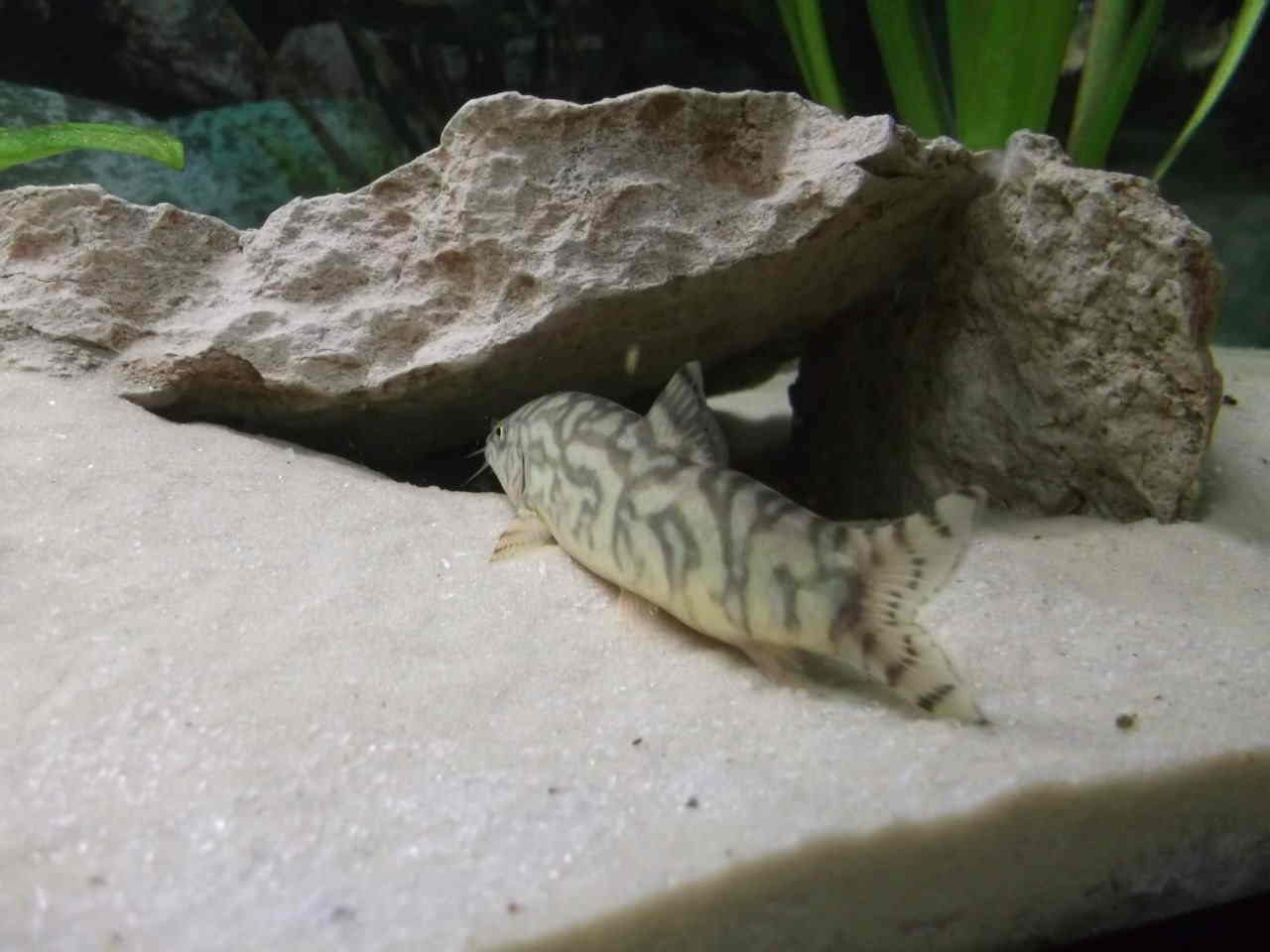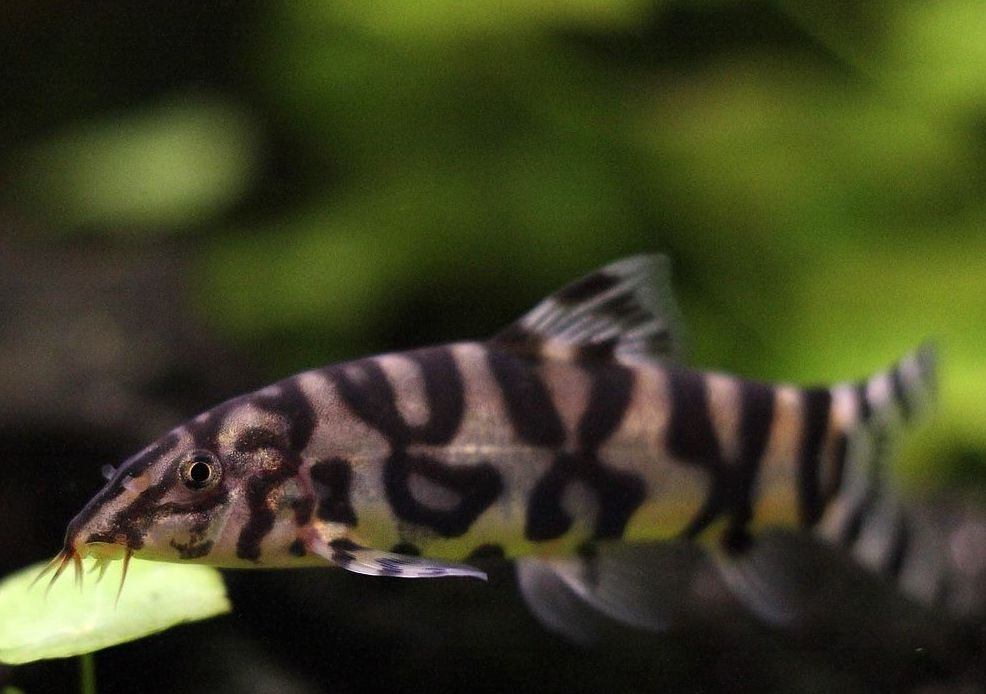The yoyo loach is a striking freshwater fish belonging to the Botiidae family, known for its captivating appearance and playful behavior. Characterized by a silvery body adorned with dark vertical stripes, the yoyo loach can also display a bluish shimmer, especially in breeding individuals.
Native to the rivers of India and Pakistan, yoyo loaches are popular among aquarists due to their unique aesthetics and engaging personality.

Contents
Habitat in the wild
The yoyo loach, commonly known as a captivating freshwater fish, belongs to the family Botiidae, often referred to as the “loach family.” This family includes various loach species, many of which are popular in the aquarium trade due to their intriguing behaviors and unique appearances.
Native to Southeast Asia, yoyo loaches are primarily found in India, Nepal, and Bangladesh. They inhabit slow-flowing rivers, streams, and freshwater bodies, thriving in calm waters such as backwaters, ponds, and lakes. Their preference for tranquil environments indicates that they do not thrive in areas with strong currents. In the wild, they often seek shelter among rocks, plants, and substrate, which they also use for burrowing.
Diet-wise, yoyo loaches are omnivorous and primarily feed on insects, crustaceans, and aquatic plants. They are known to scavenge the bottom of their habitats for food, making them excellent cleaners in a community tank, as they will consume leftover food and detritus.
Despite being commonly referred to as the Pakistani loach, true Botia almorhae is not indigenous to Pakistan. The name “yoyo fish” originated from well-known aquarium photographer Ken Childs. While documenting fish for a report, he noticed that the coloration of some loaches resembled the letters “Y” and “O.” This catchy name quickly gained popularity among readers and became widely adopted within the English-speaking aquarist community.
Understanding the yoyo loach’s natural habitat and feeding habits is crucial for aquarists looking to create an environment that promotes their well-being and highlights their engaging nature. Proper tank conditions will not only enhance their appearance but also encourage natural behaviors, making for a vibrant and lively aquarium.
| Scientific Name | Botia almorhae |
| Family | Botiidae |
| Common Names | Yoyo loach; pakistani loach; yoyo botia; yoyo fish |
| Range and habitat | India |
| Size | 14–16 cm (5.5–6.3 in) |
| Lifespan | 5-8 years |
| Ease of keeping | Medium |
| Minimum tank size | 100 liters (25 gallons) and more |
| Temperament | Peaceful |
| Diet | Omnivorous |
| Temperature | 75–81 °F (24–27 °C) |
| pH | 6.5-7.5 |
| Water hardness | 5-15 dGH |

Description
Size
The yoyo loach typically reaches a size of about 3-4 inches (7.6-10 cm) when kept in aquariums, but in their natural habitat, they can grow significantly larger, up to 15.5 cm (6.1 inches). Factors such as genetics, diet, water quality, and the specific conditions of the aquarium can influence their growth. Ensuring a spacious tank with plenty of room for swimming and exploring can help them reach their full potential size.
Lifespan
The lifespan of yoyo loaches can vary based on factors such as quality of care, genetics, and environmental conditions. In well-maintained aquariums, they can live approximately 6 to 8 years, and with exceptional care, some individuals may even surpass 10 years. To maximize their lifespan, it is essential to provide a suitable tank setup, maintain proper water parameters (ideally pH levels between 6.5 and 7.5), and offer a varied diet that includes high-quality pellets, freeze-dried foods, and occasional live or frozen options like bloodworms and brine shrimp. A stress-free environment, which includes regular water changes and adequate hiding spots, is crucial, as yoyo loaches can be sensitive to changes in their surroundings.
Body Characteristics
Yoyo loaches exhibit distinct coloration changes as they mature. Juveniles have prominent stripes that gradually transform into a characteristic net-like or marble-like pattern by the age of 3-4 months, making them visually striking adults. The pattern not only serves as camouflage in their natural habitat but also contributes to their aesthetic appeal in aquariums.
A unique feature of the Botiidae family is the presence of a hidden spine located just beneath the eyes. This spine is usually concealed within a skin “pocket,” rendering it invisible. When threatened, the spine can slide out quickly, resembling a blade. This sharp spine can pose risks during transport, as it may puncture the bag. To prevent this, using two bags—one inside the other—is recommended.
Caution is also necessary when catching yoyo loaches, as they may instinctively use these spines for self-defense, potentially getting caught in nets or causing injury to handlers. Their spines can deliver a painful jab, making it important to handle them with care. Additionally, they possess a slightly elongated, cylindrical body shape, which helps them navigate through their aquatic environments with agility.
| Characteristic | Description |
|---|---|
| Scientific Name | Botia almorhae |
| Common Names | Yo-Yo Loach, Pakistani Loach |
| Family | Botiidae |
| Origin | Southeast Asia (India, Nepal, Bangladesh) |
| Size | Typically grows to about 3-4 inches (7.6-10 cm) |
| Lifespan | 6-8 years or longer with proper care |
| Behavior | Active, playful, known for “yo-yo” swimming pattern |
| Diet | Omnivorous, accepts a variety of foods |
| Water Temperature | 75-82 degrees Fahrenheit (24-28 degrees Celsius) |
| pH Range | 6.5 – 7.5 |
| Tank Size | Minimum 20 gallons for a small group, larger for more |
| Compatibility | Generally peaceful, but can be semi-aggressive |
| Tank Setup | Provide hiding spots, caves, driftwood, plants |
| Water Flow | Moderate to low water flow preferred |
| Breeding | Difficult to breed in aquariums, not often seen |

Difficulties in keeping
Yoyo loaches are resilient fish when provided with appropriate care. However, they are not recommended for beginners due to their size, activity level, and the need for stable water parameters. As these fish can grow larger and are quite active, they require a well-maintained tank with ample space to swim and explore.
Care and keeping in a tank
Tank Size
The recommended tank size for yoyo loaches largely depends on the number of individuals you plan to keep and any other fish or inhabitants in the same aquarium. As active and social fish, yoyo loaches appreciate ample space to swim and explore, thriving best in small groups.
For a small group of yoyo loaches (3-5 individuals), a tank size of at least 20 gallons is a good starting point. This size allows them to exhibit their natural behaviors, including their playful “yo-yo” swimming pattern, and provides enough space for comfortable coexistence. It’s important to ensure that the tank is long rather than tall, as yoyo loaches prefer horizontal swimming space.
If you plan to keep a larger group or include other fish species, consider opting for a larger tank, such as 30 or 40 gallons. A larger tank offers more swimming room and enables you to create a more diverse and stable ecosystem.
When determining the appropriate tank size, remember to account for the full adult size of the fish, the amount of decor (such as hiding spots and plants), and compatibility with other tank inhabitants. A larger tank equipped with appropriate filtration and regular maintenance will ensure a healthier and more comfortable environment for your yoyo loaches.
Tank Decor
To help yoyo loaches feel secure, it’s essential to include plenty of covers in the tank. Caves, driftwood, and plants serve as great hiding spots. The substrate should be fine and rounded, as these fish actively dig and can injure their barbels on sharp edges. Substrates like sand or smooth gravel work well.
Yoyo loaches particularly enjoy narrow spaces, so incorporating ceramic or plastic tubes can create ideal hiding spots. These fish are adept at squeezing into tight areas, so it’s wise to check periodically to ensure none are stuck in narrow crevices. Additionally, consider using rocks and driftwood to create caves and overhangs that mimic their natural habitat.
Providing plenty of covers will help them feel comfortable and secure. Incorporate live or silk plants to add greenery and help maintain water quality.
Moderate, diffused lighting is recommended, as it mimics their natural habitat and reduces stress. Avoid direct bright lights, as yoyo loaches can become skittish in harsh lighting.
Water Parameters
Yoyo loaches are quite sensitive to water parameters and purity, making it crucial not to introduce them to a new tank with unstable conditions. Effective filtration and frequent water changes are necessary to maintain a healthy environment.
Optimal Water Conditions:
- Temperature: 75-82°F (24-28°C) – Yoyo loaches prefer slightly warmer water; however, stability is key. The optimal temperature is around 25°C. With adequate aeration, they can tolerate temperatures up to 30°C, but prolonged exposure to higher temperatures should be avoided as it can reduce oxygen levels.
- pH Level: 6.5 – 7.5 – Aim for slightly acidic to slightly alkaline conditions. Avoid drastic pH fluctuations, as stability is important for their health.
- Water Hardness: 5-12 dGH (degrees General Hardness) – Yoyo loaches can tolerate various hardness levels but should avoid extremes. Regular testing can help keep hardness within this range.
- Ammonia and Nitrite: Both should consistently be at 0 ppm, as these compounds are toxic to fish. Using a reliable test kit can help monitor these levels.
- Nitrate: Keep nitrate levels below 40 ppm. Regular water changes are essential to control nitrate buildup, as high levels can lead to stress and health issues.
- Water Movement: Moderate water flow is generally suitable, reflecting their natural habitats, which feature varying water flow rates. Using a filter with adjustable flow settings can help create a balanced environment.
Regular water testing and maintenance are vital to keeping these parameters within acceptable ranges. Yoyo loaches are hardy fish, but consistent care is crucial for their health and longevity. Performing partial water changes, maintaining a proper filtration system, and monitoring water quality will help create a stable and healthy environment for your yoyo loaches.

Diet
Caring for yoyo loaches is straightforward, as they are not picky eaters and will accept various types of food. Being bottom feeders, it’s essential to provide food that reaches the bottom of the tank. Since yoyo loaches are primarily nocturnal, it’s best to feed them shortly before turning off the lights. Options include sinking granules or frozen foods that settle on the substrate.
Yoyo loaches particularly enjoy live foods such as bloodworms and tubifex. They are also known for their appetite for snails, making them an effective natural solution for controlling snail populations in your aquarium. If you’re looking to reduce snail numbers, introducing yoyo loaches can achieve noticeable results within just a few days.
However, it’s crucial to avoid overfeeding, as yoyo loaches have a tendency to eat excessively. They can easily become insatiable, so it’s important to provide appropriate portions and monitor their feeding habits to prevent obesity and related health issues. Regularly removing any uneaten food after feeding can help maintain water quality and ensure a healthy environment for your fish.

Tank mates
As a rule they are good tank mates for other kinds of fishes, but it’s better to avoid aggressive tank mates and raptorial feeders. If the yoyo loach feels safe, the majority of the time it spends in covers and it can even refuse from feeding.
However, yoyo loach could never complain about bad appetite. It can’t be said that the yoyo loach is a good tank mate for species of the same kind, since in a school an alpha male fish becomes a chief and sometimes he haunts other males. But these fights never end up with any serious injuries.
Here are some suitable tank mates:
- Other Loach Species: Many loach species have similar behaviors and water requirements. Clown Loaches, Kuhli Loaches, and other Botia species can make good companions for Yo-Yo loaches.
- Barbs: Peaceful barb species like Cherry Barbs and Rosy Barbs can work well with Yo-Yo loaches. Just be cautious with larger or more aggressive barb species.
- Rasboras and Tetras: Small and peaceful rasboras (e.g., Harlequin Rasboras, Chili Rasboras) and tetras (e.g., Neon Tetras, Cardinal Tetras) can coexist harmoniously.
- Corydoras Catfish: Corydoras catfish are bottom-dwellers and won’t compete for the same areas of the tank as Yo-Yo Loaches. They’re peaceful and compatible tank mates.
- Gouramis: Peaceful gouramis like Dwarf Gouramis can work, but avoid larger or more aggressive gourami species.
- Livebearers: Some livebearer species, such as Platies and Swordtails, can be suitable tank mates as long as they’re not too aggressive.
- Small Plecos: Smaller pleco species like Bristlenose Plecos can coexist peacefully with Yo-Yo loaches.
Gender differences: male vs female
Distinguishing between male and female yoyo loaches can be quite challenging due to the lack of prominent external differences. Unlike some fish species with distinct features, yoyo loaches do not exhibit clear sexual dimorphism. As a result, differentiating the sexes based solely on appearance is difficult.
The most reliable method for identifying males and females is through their behavior during spawning, which occurs rarely in home aquariums. If you’re considering breeding yoyo loaches, you’ll need to create specific conditions to encourage this behavior. Observing courtship rituals can provide insights into the sexes, as males may display more active behavior when courting females. However, without specialized equipment or detailed knowledge of their internal anatomy, it can be nearly impossible to determine their sex with certainty in a typical aquarium setting. For hobbyists focused on keeping yoyo loaches as pets rather than breeding, this lack of visible differences shouldn’t detract from the enjoyment of these fascinating fish.
Breeding Yoyo Loaches
Breeding yoyo loaches in captivity can be challenging, and successful spawning is relatively rare in home aquariums. These loaches have complex breeding behaviors that require specific conditions to replicate their natural environment. Here are some steps to consider if you’re interested in attempting to breed yoyo loaches:
Group Setup: Start with a small group of yoyo loaches, aiming for a balanced ratio of males to females. A larger tank with ample hiding spots, such as caves or PVC pipes, is crucial for their comfort and safety.
Water Conditions: Ensure optimal water parameters for breeding. Maintain a temperature between 78-82°F (26-28°C), slightly acidic to neutral pH (around 6.5-7.0), and moderately hard water.
Diet and Conditioning: Provide a varied and high-quality diet to condition the loaches for breeding. Incorporating live or frozen foods, such as bloodworms, brine shrimp, and daphnia, can help boost their health and readiness for spawning.
Water Changes: Conduct frequent small water changes using slightly cooler water (a few degrees lower) to simulate the rainy season, which can sometimes trigger breeding behavior.
Natural Triggers: Mimic natural breeding conditions by replicating the environmental changes associated with the rainy season, such as increased water flow and cooler temperatures.
Spawning Behavior: Monitor the group closely for signs of breeding behavior, such as males chasing females or engaging in courtship displays. Look for suitable spawning sites, as this will indicate that they are ready to breed.
Eggs and Fry: If successful, the female will lay adhesive eggs, which the male will fertilize. Once hatched, raising the fry can be particularly challenging, as they have specific dietary needs and are sensitive to water conditions.
Even with ideal conditions, yoyo loaches may not readily breed in home aquariums. Successful breeding depends on numerous factors, including time, patience, and experience. If breeding yoyo loaches is your goal, consider researching experiences from other breeders and seeking advice from experienced hobbyists who have succeeded with this species.